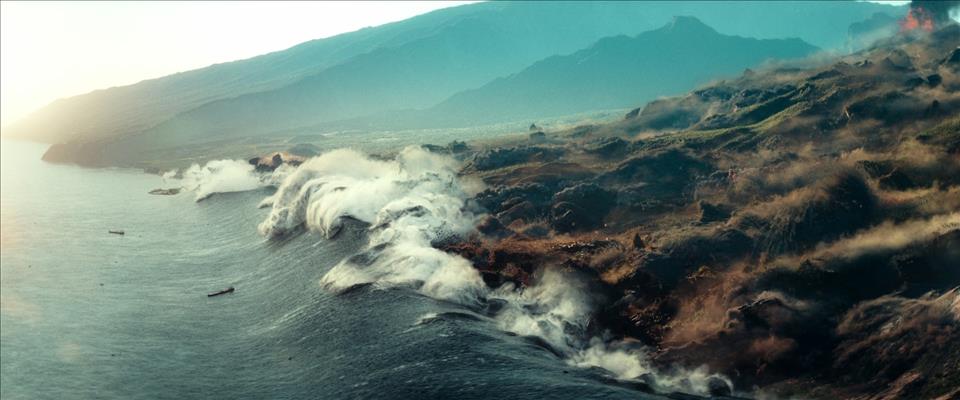
Netflix's La Palma's 'Megatsunami' Has Been Debunked
It's a truly terrifying prospect.
Disaster stories are hugely popular and La Palma is just the latest hit in the growing genre. In his book Disaster Mon Amour , the film critic David Thomson identifies the filmmakers' goal of creating“a spectacle of devastation with cozy human interest”. But stories like La Palma can have real world impact.
The series presents itself as being based on a real hypothesis, which is communicated by newscasters and a scientist in the title sequence of each episode. The tsunami expert Simon Day, whose research inspired the show, is also thanked in the closing credits. However, La Palma does nothing to capture the more up to date and reassuring science.
Looking for something good? Cut through the noise with a carefully curated selection of the latest releases, live events and exhibitions, straight to your inbox every fortnight, on Fridays. Sign up here .
While volcanic events can trigger tsunamis, as experts in volcanoes and the communication of disaster, we can assure you that the eruption and subsequent rapid collapse of the island depicted in the series isn't a plausible scenario that scientists are concerned about.
What should be taken more seriously are localised tsunamis. Such“megatsunami” scenarios have been debunked in recent years you'll be happy to hear.
There have been more than 17 eruptions in the Canary Islands since the 1400s, none resulting in a“megatsunami” across the Atlantic.
Stories have the power to communicate information about environmental risk for audiences . Following the release of the film, some have dug up the megatsunami hypothesis, raising it back into the public awareness.
The idea of a“megatsunami”, triggered in the way it is in La Palma, first arose in a 2001 paper by the academic the series thanks in its credits, Simon Day and the geophysicist Steven Ward based on one extreme hypothetical scenario. This theory has since been proven false by subsequent studies that show that a Canary Islands eruption and collapse might reach the US with a maximum wave height similar to a storm surge at one to two metres , not the 25-metre waves depicted in La Palma. Newer research has also called into question the scale of the landslide used in the original study which would cause such a tsunami.
Since the initial work, we understand a lot more about how large landslides and tsunamis occur, and the computer models used to test tsunami scenarios have improved. Research on the underwater landslide deposits has shown that these collapses occur in multiple, smaller steps, not one massive slide into the ocean. Such a large tsunami would leave telltale deposits in North and South America – but they are nowhere to be found.
The importance of understanding the risk relating to real volcanoes was encapsulated during the 2021 eruption of Cumbre Vieja. As the eruption progressed, volcanologists received messages from concerned and frightened people fearing a megatsunami, which prompted the US Geological Survey to respond outlining why the hypothesis doesn't carry. This was even before a major Netflix drama had recounted such an imaginary event.
The volcano erupting in the series La Palma. Jan Richer Friis/Netflix
Volcanogenic tsunamis of all sizes are a real threat around the world and hazards experts want to know what our risks are so we can prepare and protect our communities. This becomes difficult when facts are diluted or distorted by stories like La Palma's. Volcanologists with limited resources during an eruption end up spending more time debunking information rather than talking to the press about the potential dangers.
During the 2021 eruption, the people of La Palma suffered greatly and continue to struggle with claiming compensation and rebuilding their homes or accessing their properties . Tourist numbers dropped to a third of pre-pandemic levels after 2021's volcanic eruption.
Misinformation about eruptions and their risks can add to the stress of those inhabiting or visiting volcanic islands, not only concerned about their own safety, but the security of an economy that relies heavily on tourism. With the right information, we can empower communities to prepare themselves and to act fast when the time comes.
A lot of people watch Netflix, but not many people read scientific papers on volcanology. Given this, it might be that the responsibility of getting the science right and accurately representing risk should lie with the people with a captive audience. There is an opportunity to work with scientists to help spread the right information alongside promotion for future stories about such disasters.
Simon Day was approached for comment but hadn't responded by the time this article was published.

Legal Disclaimer:
MENAFN provides the
information “as is” without warranty of any kind. We do not accept
any responsibility or liability for the accuracy, content, images,
videos, licenses, completeness, legality, or reliability of the information
contained in this article. If you have any complaints or copyright
issues related to this article, kindly contact the provider above.


















Comments
No comment